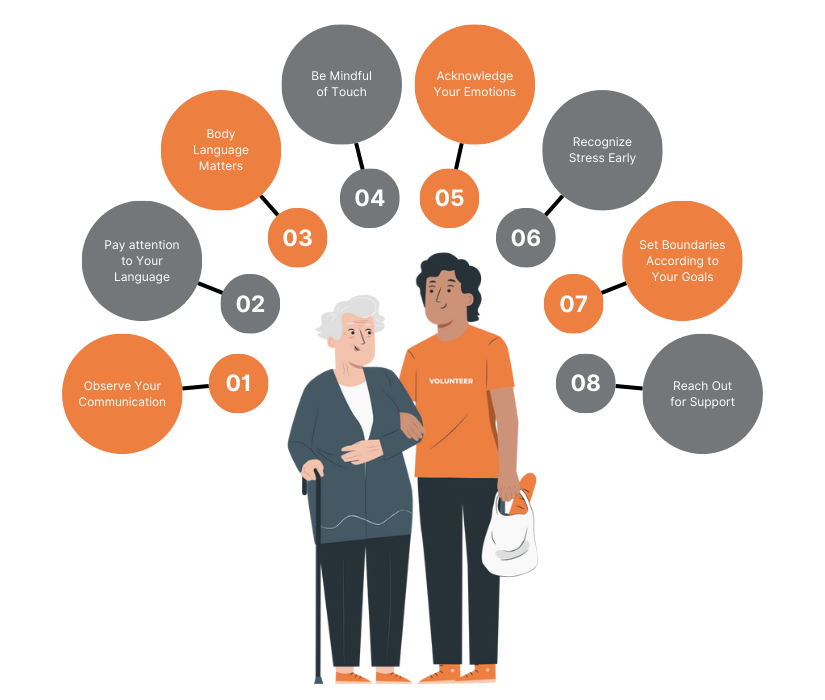
“Sure, Sir, I’ll help.” As soon as she spoke the words, Alexa thought, “I do not have time or energy for this! Why did I agree to help?”
Sometimes, you might automatically say “yes” without thinking, especially when you’re emotionally tied to a situation or feel a heavy sense of guilt. Over time, these automatic agreements can become your standard, something you feel you must maintain or achieve.
But as a resilient caregiver, it’s crucial to recognize the importance of your own life, family, and work. Setting boundaries is about striving to care within those limits. It doesn’t mean you’re any less dedicated to caregiving; it shows your commitment to caring with compassion and devotion while ensuring you don’t lose yourself in the role.
Healthy boundaries allow you to maintain an emotional connection with the person you care for without constantly falling into negative patterns like needing to rescue, enable, fix, or control. They allow you to be yourself, love, and care for someone while taking personal responsibility for your actions.
Professional boundaries are the barriers for caregivers, defining the limits of their relationship with clients. They’re crucial for ensuring caregivers can do their job effectively while keeping interactions healthy.
So, where do these boundaries lie? Think of it as finding a sweet spot between being too distant and too involved. It’s like a Goldilocks situation – not too hot or cold, but just right.
Being too hands-off or under-involved can lead to neglect or indifference while being too invested or over-involved can break the rules or cross boundaries. Both extremes show a lack of skill in caregiving.
By setting and sticking to these boundaries, caregivers can dodge stressful situations, prevent burnout, balance work and personal life, steer clear of misconduct, and ensure they provide the right care level. It’s all about maintaining a healthy, professional relationship while giving your best to those you care for.

Defining Your Role as a Caregiver
It’s important to have a clear understanding of your responsibilities as a caregiver. Your main job is to offer support and care while maintaining a professional distance. This means you should focus on providing quality care without letting personal feelings or relationships interfere. Keeping this separation helps you stay objective and dedicated to the client’s needs, ensuring that your care remains effective and professional.
Differentiating Between Personal and Professional Relationships
Building a rapport with clients is important, but it’s crucial to maintain a clear line between personal and professional relationships. While being friendly and compassionate is okay, try not to become overly familiar or share too much personal information. This helps keep the relationship focused on the client’s needs rather than personal connections. Maintaining this balance ensures that the caregiving relationship remains professional and effective.
Recognizing Signs of Boundary Crossing
Being aware of when boundaries are being crossed is key to maintaining professionalism. Watch for signs such as clients making personal requests or you finding yourself sharing more personal details than intended. These signs indicate that the professional boundaries may be blurring, and addressing these issues promptly is important. By recognizing and addressing boundary crossings early, you can prevent potential problems and maintain the integrity of the caregiving relationship.
Common Boundary Violations in Caregiving
Boundary violations in caregiving can take many forms. Examples include accepting gifts, becoming emotionally too involved with clients, or mixing personal and professional roles. These violations can create conflicts of interest and undermine the professionalism of your caregiving. It’s essential to be aware of these potential pitfalls and avoid them to ensure a clear and professional caregiving relationship.
Communicating Expectations Clearly
From the beginning, setting and communicating clear expectations with clients and their families is crucial. Clearly outline what your role involves, what behaviors are acceptable, and what is not. This helps avoid misunderstandings and ensures that everyone is on the same page. Regularly revisiting and reinforcing these expectations helps maintain a professional environment and keeps the relationship focused on the client’s needs.
Establishing Limits and Consequences
Establishing limits and consequences involves defining what behaviors are acceptable and what will happen if those boundaries are violated. For example, if a client starts making excessive personal requests or crossing professional lines, you should have a clear policy to address these situations. Consistently enforcing these limits helps maintain professionalism and ensures that boundaries are respected by everyone involved.
Balancing Empathy with Professionalism
Balancing empathy with professionalism means showing that you care about your clients while maintaining a professional demeanor. Being supportive and understanding is important to avoid becoming too emotionally involved or overly familiar. This balance helps you provide the best care while keeping the relationship professional and focused on the client’s needs.
Techniques for Saying “No”
Learning to say “no” effectively is important for maintaining boundaries. When faced with requests or situations that don’t align with your role or professional standards, it’s essential to decline politely and clearly. Using respectful language to set limits helps maintain professionalism and prevents misunderstandings. It’s about being firm yet polite, ensuring boundaries are respected without offending.
Seeking Support from Colleagues or Supervisors
Don’t hesitate to seek support from colleagues or supervisors when dealing with boundary issues. Sharing your experiences and challenges with others who understand your role can provide valuable perspectives and advice. This support system helps you navigate difficult situations and reinforces your ability to maintain professional boundaries. Regular discussions with peers or supervisors can offer new ideas and encouragement to handle boundary concerns effectively.
Social Media and Technology
Social media and technology can blur professional boundaries if not managed properly. It’s a good practice to keep your personal and professional online lives separate. Avoid connecting with clients or their families on social media platforms to protect privacy and maintain a professional relationship. Keeping these aspects of your life separate helps prevent potential issues and ensures that interactions remain professional.
Physical Touch
When it comes to physical touch, it’s important to follow professional guidelines and always respect personal space. Any necessary physical contact should be approached with clear consent and only when it is appropriate for the caregiving situation. Maintaining professional standards regarding physical touch helps ensure that interactions remain respectful and focused on the client’s care.
Gifts and Favors
Receiving gifts or favors from clients can complicate professional boundaries. It’s helpful to have a clear policy on accepting such items. Politely declining gifts helps prevent any appearance of favoritism or conflicts of interest. Maintaining a professional stance on gifts ensures that the caregiving relationship remains unbiased and focused on the client’s needs.
Self-Disclosure
Self-disclosure involves being cautious about sharing personal information with clients. Keeping conversations centered on the client’s needs and avoiding sharing too much about your life helps maintain a professional distance. This approach ensures that the focus remains on providing quality care rather than personal details.
Client Confidentiality
Protecting client confidentiality is crucial in maintaining professional boundaries. Always safeguard client information and share details only with those directly involved in their care. Upholding client confidentiality builds trust and ensures sensitive information is handled respectfully and professionally.
The Importance of Self-Care
Self-care is essential for maintaining your well-being and effectiveness as a caregiver. Taking time for yourself and engaging in enjoyable activities helps manage stress and keeps you emotionally strong. Regular self-care practices are crucial for sustaining your ability to provide high-quality care and maintain professional boundaries.
Strategies for Managing Stress and Emotions
Managing stress and emotions effectively is key to preventing burnout. Develop healthy coping mechanisms, such as regular exercise, mindfulness practices, and having a strong support system. These strategies help you handle the emotional demands of caregiving and maintain a healthy work-life balance.
Seeking Professional Help When Needed
If you’re struggling with maintaining boundaries or feeling overwhelmed, seeking professional help can be beneficial. Consulting with a mental health professional provides support and guidance to address these challenges. Early intervention helps ensure that you continue to provide excellent care while taking care of your well-being.
If you’re serious about taking your caregiving team to the next level and ensuring they’re maintaining those professional boundaries, then you need to check out Learn2Care. With Learn2Care, your team gets access to top-notch caregiver training that’s tailored to their needs.
Here’s what we bring to the table:
Benefits for Agencies-
Benefits for Caregivers
So, what are you waiting for? Upskill your team, Learn2Care, and watch your caregivers become certified caregiving professionals.
Contact us to inquire about our state-wise training courses and take the first step towards upskilling your team with a 14-day free trial!